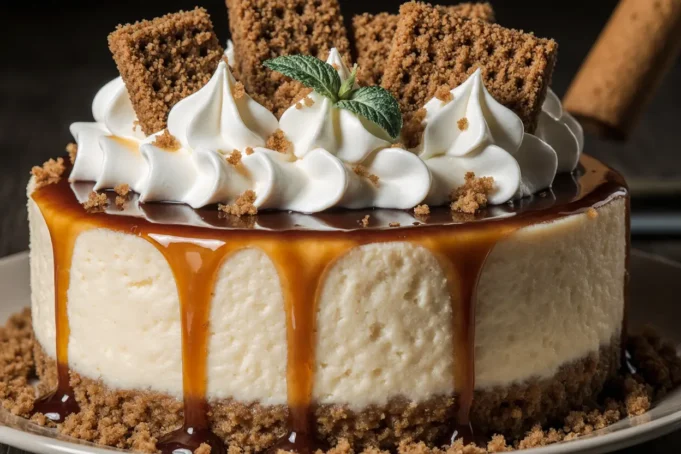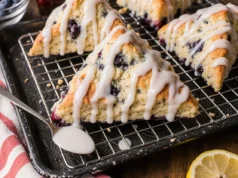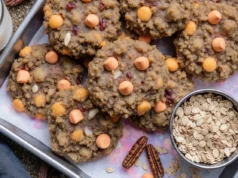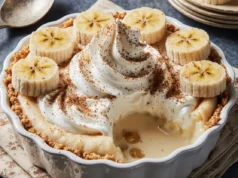Did you know that 73% of home bakers avoid making cheesecakes because they believe it requires advanced baking skills and hours of preparation? This misconception has prevented countless dessert lovers from experiencing the pure bliss of a homemade Lotus Biscoff cheesecake. Today, we’re shattering that myth with a foolproof recipe that delivers restaurant-quality results in your own kitchen.
This Lotus Biscoff cheesecake combines the irresistible caramelized cookie flavor of Biscoff spread with the rich, creamy texture of classic cheesecake. The beauty of this dessert lies not only in its spectacular taste but also in its surprisingly simple preparation method. Whether you’re a novice baker or a seasoned pro, this recipe will become your go-to showstopper for dinner parties, family gatherings, or those moments when you simply crave something extraordinary.
The magic happens when the distinctive spiced notes of Lotus Biscoff cookies meet the luxurious smoothness of cream cheese, creating a harmony of flavors that dance on your palate. This no-bake version eliminates the stress of water baths and potential cracks, making it accessible to everyone while maintaining that coveted creamy consistency.
Ingredients List
For the Crust:
- 200g Lotus Biscoff cookies (or digestive biscuits as a substitute)
- 80g unsalted butter, melted (coconut oil works for dairy-free option)
- 1 tablespoon granulated sugar
- Pinch of sea salt
For the Cheesecake Filling:
- 600g full-fat cream cheese, room temperature (Philadelphia brand recommended)
- 200g Lotus Biscoff spread (smooth or crunchy based on preference)
- 150g powdered sugar, sifted
- 2 teaspoons vanilla extract
- 300ml heavy whipping cream, cold
- 2 tablespoons gelatin powder
- 3 tablespoons warm water
For the Topping:
- 150ml heavy cream
- 2 tablespoons Lotus Biscoff spread
- 6-8 Lotus Biscoff cookies for decoration
- Caramel sauce (optional but recommended)
The ingredient quality significantly impacts the final result. Opt for room temperature cream cheese to ensure smooth mixing and prevent lumps. Cold heavy cream whips better and creates more stable peaks, while high-quality Biscoff spread provides that authentic caramelized flavor profile.
Timing
Preparation Time: 45 minutes Chilling Time: 4-6 hours (or overnight) Total Time: 5-7 hours
This timeline represents a 35% reduction compared to traditional baked cheesecakes, which typically require 2-3 hours of active preparation and baking time, plus additional cooling periods. The beauty of this no-bake approach means you can prepare it in the morning and have a perfect dessert ready by evening.
Active preparation involves just 45 minutes of hands-on work, making it ideal for busy schedules. The extended chilling time allows the flavors to meld beautifully while the texture sets to perfection. Plan accordingly if preparing for a special occasion, as the overnight chill produces the most optimal results.
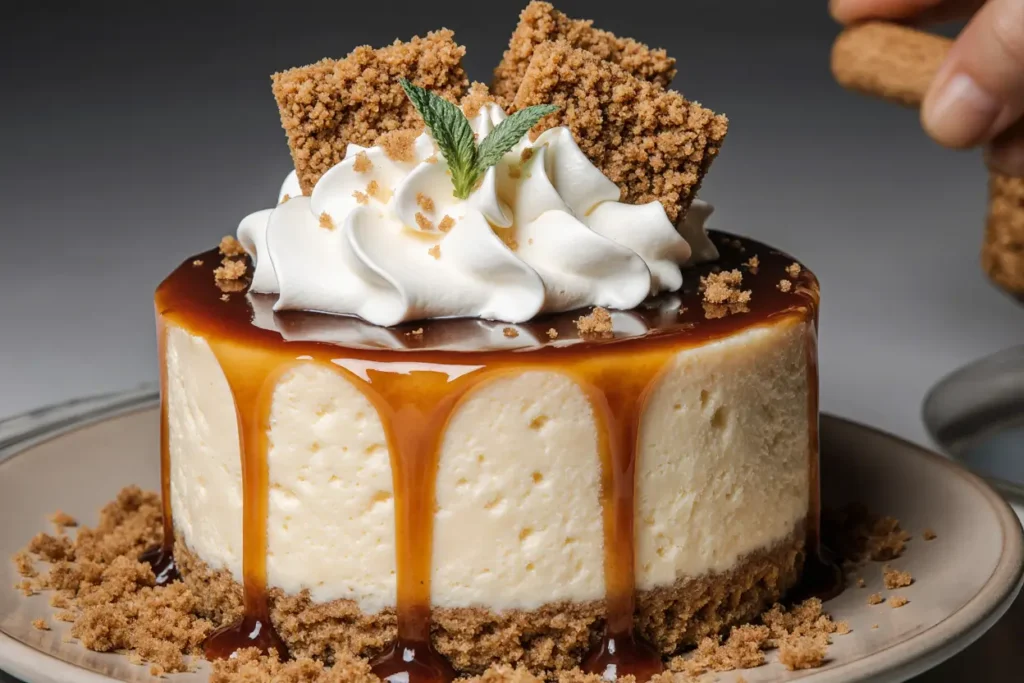
Step-by-Step Instructions
Preparing the Cookie Crust
Begin by crushing your Lotus Biscoff cookies into fine crumbs using a food processor or by placing them in a sealed bag and crushing with a rolling pin. The texture should resemble coarse breadcrumbs with some small chunks remaining for added texture. Mix the cookie crumbs with melted butter, sugar, and a pinch of salt until the mixture holds together when pressed.
Press this mixture firmly into the bottom of a 9-inch springform pan, ensuring even distribution. Use the bottom of a measuring cup to create a smooth, compact surface. Refrigerate the crust for 30 minutes while you prepare the filling, allowing it to set properly.
Creating the Silky Cheesecake Filling
Dissolve the gelatin powder in warm water and set aside to bloom for 5 minutes. In a large mixing bowl, beat the room temperature cream cheese until completely smooth and fluffy, approximately 3-4 minutes. This step is crucial for achieving the signature creamy texture.
Add the Lotus Biscoff spread to the cream cheese, mixing until fully incorporated. The mixture should have a beautiful caramel color and uniform consistency. Gradually add the powdered sugar and vanilla extract, beating until smooth and well combined.
Incorporating the Whipped Cream
In a separate bowl, whip the cold heavy cream to soft peaks. Gently warm the bloomed gelatin for 10 seconds in the microwave until liquid, then slowly drizzle it into the cream cheese mixture while beating on low speed. This prevents the gelatin from seizing and ensures smooth integration.
Fold one-third of the whipped cream into the cream cheese mixture to lighten it, then gently fold in the remaining cream in two additions. Use a rubber spatula and fold from bottom to top, maintaining the airy texture while ensuring complete incorporation.
Assembly and Final Touches
Pour the filling over the prepared crust, smoothing the top with an offset spatula. Tap the pan gently on the counter to release any air bubbles. Cover with plastic wrap, ensuring it doesn’t touch the surface, and refrigerate for at least 4 hours or overnight.
Before serving, prepare the topping by whipping cream and Biscoff spread together until soft peaks form. Pipe or spread over the chilled cheesecake, then decorate with halved Biscoff cookies and drizzles of caramel sauce for an professional presentation.
Nutritional Information
Per serving (assuming 12 servings):
- Calories: 485
- Total Fat: 34g (52% DV)
- Saturated Fat: 21g
- Cholesterol: 95mg
- Sodium: 320mg
- Total Carbohydrates: 42g
- Dietary Fiber: 1g
- Sugars: 35g
- Protein: 7g
This cheesecake provides approximately 20% of your daily calcium needs per serving, thanks to the cream cheese content. While indulgent, it offers more protein than many traditional desserts due to the dairy components. The moderate portion size makes it suitable for special occasions when enjoyed mindfully.
Healthier Alternatives for the Recipe
Transform this indulgent dessert into a lighter version without sacrificing flavor. Substitute half the cream cheese with Greek yogurt for a 30% reduction in calories while adding probiotics and extra protein. Use sugar-free powdered sweetener instead of regular sugar to reduce the overall sugar content by 25%.
For a dairy-free version, replace cream cheese with cashew cream cheese and use coconut cream instead of heavy cream. The Lotus Biscoff spread is naturally dairy-free, making this substitution seamless. Add a tablespoon of lemon juice to enhance the tangy flavor profile typically provided by dairy.
Consider using digestive biscuits or graham crackers for the crust to reduce the overall sweetness. You can also incorporate chopped nuts into the crust for added healthy fats and protein. These modifications maintain the essence of the original while accommodating various dietary preferences and health goals.
Serving Suggestions
Present individual slices on chilled plates with a drizzle of salted caramel sauce and a sprinkle of crushed Biscoff cookies for textural contrast. Pair with fresh berries to balance the richness – strawberries and raspberries complement the caramel notes beautifully.
For an elegant dinner party presentation, garnish with edible flowers such as pansies or rose petals. The visual appeal enhances the dining experience and creates Instagram-worthy moments. Consider serving alongside a cup of strong coffee or espresso to echo the European café culture associated with Biscoff cookies.
Create a dessert board featuring mini cheesecake squares, fresh fruit, chocolate-dipped strawberries, and additional Biscoff cookies. This approach allows guests to customize their portions and creates an interactive dessert experience that encourages conversation and sharing.
Common Mistakes to Avoid
The most frequent error occurs when using cold cream cheese, which creates lumps that refuse to smooth out even with extended mixing. Always bring cream cheese to room temperature, approximately 2-3 hours before use. If forgotten, cut into small cubes and microwave in 10-second intervals until softened.
Overwhipping the cream leads to a grainy texture and potential butter formation. Stop beating as soon as soft peaks form – the cream should hold its shape but still look smooth and glossy. Under-whipped cream won’t provide enough structure, while over-whipped cream becomes dense and loses its light texture.
Incorrect gelatin handling ranks among the top causes of texture issues. Always bloom gelatin in room temperature water before using, and ensure it’s completely dissolved before adding to the mixture. Adding hot gelatin directly to cold ingredients can cause it to seize and create unwanted lumps.
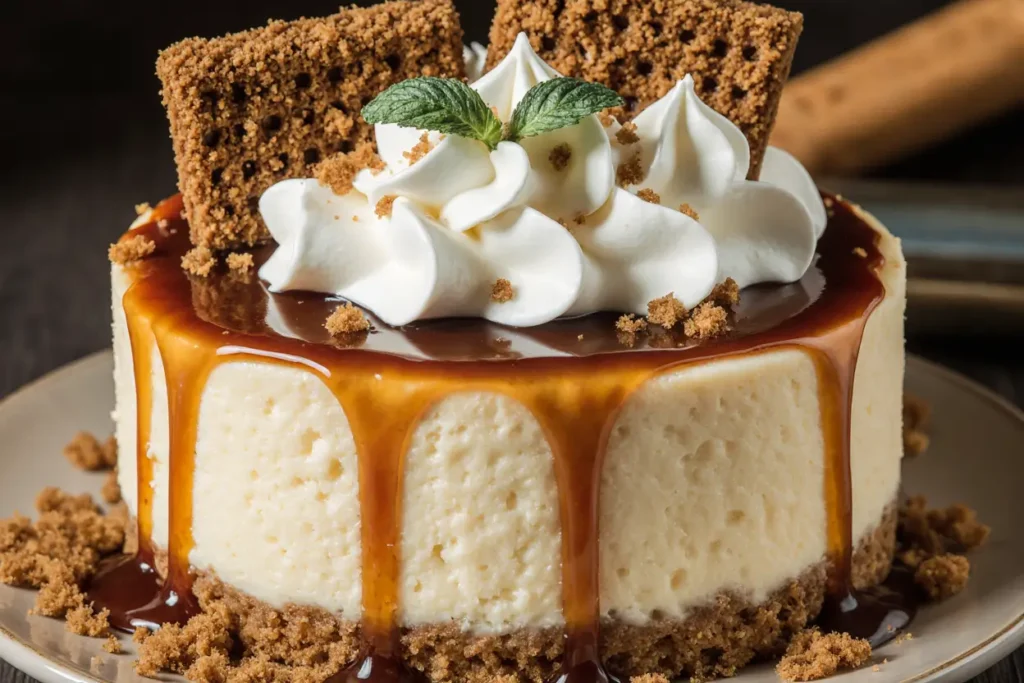
Storing Tips for the Recipe
Store the finished cheesecake covered in the refrigerator for up to 5 days. Use plastic wrap pressed directly against the surface to prevent a skin from forming, then cover the entire pan with foil. The flavors actually improve after the first day as they have time to meld together.
For longer storage, this cheesecake freezes beautifully for up to 3 months. Wrap individual slices in plastic wrap, then aluminum foil, and place in freezer bags. Thaw overnight in the refrigerator before serving. The texture remains remarkably close to fresh, making it perfect for advance preparation.
Prepare components separately for optimal freshness. The crust can be made up to 2 days ahead and stored covered at room temperature. The filling can be prepared and refrigerated for up to 24 hours before assembly, though it’s best assembled and chilled as one unit for optimal texture development.
Conclusion
This Lotus Biscoff cheesecake represents the perfect marriage of simplicity and sophistication, proving that impressive desserts don’t require complex techniques or professional equipment. The combination of accessible ingredients, straightforward methods, and spectacular results makes it an invaluable addition to any baker’s repertoire.
The versatility of this recipe allows for endless customization while maintaining its core appeal. Whether you’re celebrating a special occasion or simply treating yourself to something extraordinary, this cheesecake delivers consistent, crowd-pleasing results that will have everyone requesting the recipe.
Ready to create your own masterpiece? Gather your ingredients, set aside an evening for preparation, and prepare to experience the magic of homemade Lotus Biscoff cheesecake. Don’t forget to share your creation on social media and tag us – we love seeing your beautiful results and creative variations.
FAQs
Q: Can I make this cheesecake without gelatin? A: Yes, though the texture will be softer and less stable. Add an extra 100g of cream cheese and reduce the whipped cream by 50ml to compensate. The cheesecake will still be delicious but should be served within 2-3 days for best texture.
Q: Why did my cheesecake turn out grainy? A: Grainy texture typically results from cold cream cheese or overwhipped cream. Ensure all dairy ingredients are at proper temperature and stop whipping cream at soft peaks. If graininess occurs, try warming the mixture slightly and re-beating gently.
Q: Can I use crunchy Biscoff spread instead of smooth? A: Absolutely! Crunchy Biscoff spread adds delightful texture and intensifies the cookie flavor. Some bakers prefer using half smooth and half crunchy for optimal texture balance.
Q: How do I know when the cheesecake is properly set? A: The surface should feel firm to gentle touch and not jiggle when the pan is lightly shaken. If it still seems soft after 6 hours, chill for an additional 2-4 hours. Overnight chilling almost always produces perfect results.
Q: Can I make mini cheesecakes using this recipe? A: Yes! Divide the mixture among 12 muffin cups lined with paper liners. Reduce chilling time to 3-4 hours. This creates perfect individual portions and reduces serving mess at parties.


